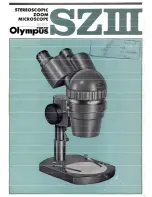
-9-
△
To confirm polarized light’s vibration direction, choose a
cleavage black
mica, putting it in field center, then rotating the stage until the black
mica color getting the darkest, the black mica cleavage direction is the
polarized light’s vibration direction.
6. Maintenance
6.1 Clean microscope
6.1.1 Don’t touch the lens with hand, Dust on lens should be cleaned by
soft brush or absorbent cotton or cleaned by absorbent cotton, lens paper
with the mixture of alcohol and ether (proportion 1:4).
6.1.2 Alcohol and ether all are burnt early, please take them away from
fire. Be careful for turn on and off power.
6.1.3 Don’t clean painted metal and galvanizing metal with organic
solvent such as alcohol, ether or the mixture of the both. Silicon cloth or
soft cleaning preparation is suggested to clean it.
6.1.4 Plastic should be cleaned by soft cloth with clear water.
6.2 Environment of using and placing
6.2.1 Microscope should be used and placed in a cool, dry, non-dust,
non-shake and non-corrosive gases environment.
O
1
I
O
1
I
O
1
I
O
O
1
I
O
1
2
5
4
3
stage rotation
center adjustment
sketch map































